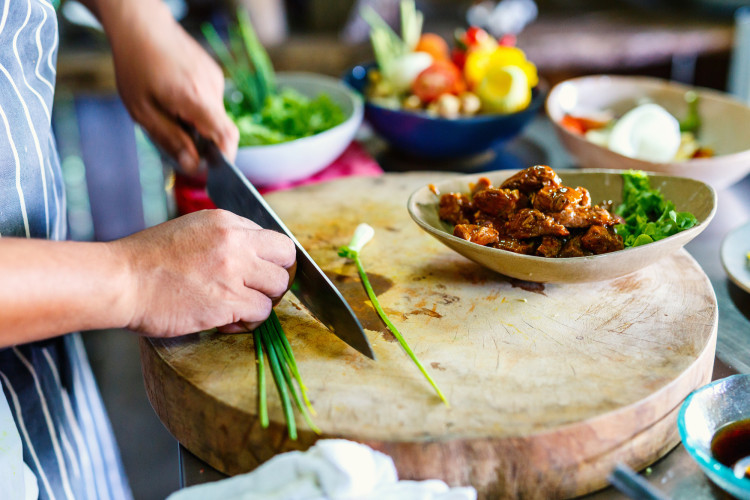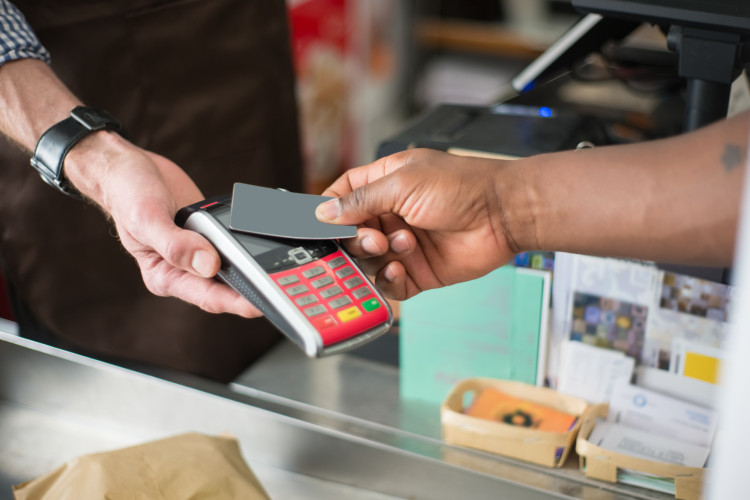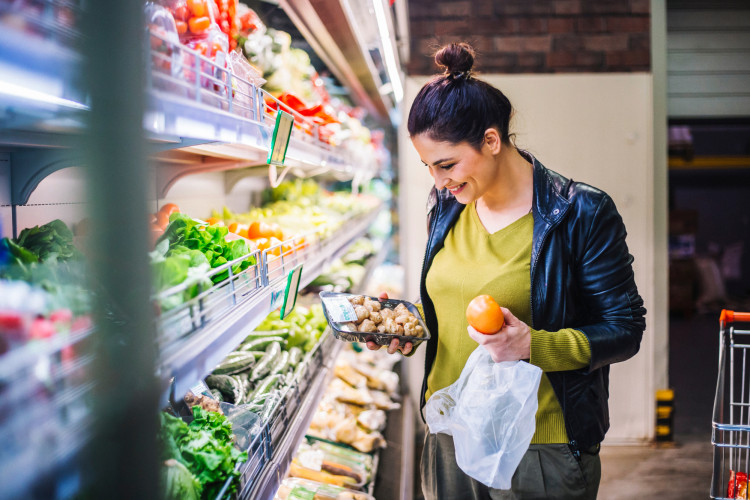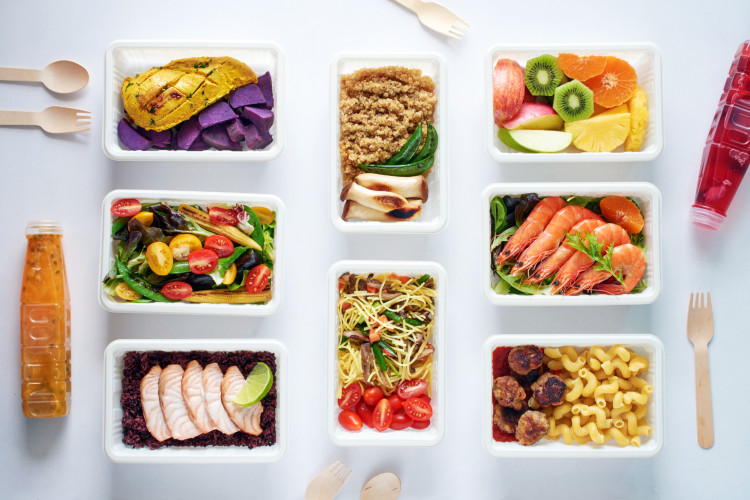Saving money on groceries in 2024 can feel like a daunting task, but with the right strategies, it’s entirely achievable. At Savewhere.net, we’re dedicated to helping you discover practical ways to cut down your grocery bill without sacrificing the quality and enjoyment of your meals. Let’s dive into actionable tips and tricks to help you become a savvy shopper and master the art of frugal food shopping, budget-friendly eating, and mindful spending.
1. Unleash Your Inner Chef: Cook More Meals At Home
Cooking at home is the cornerstone of saving money on groceries. Pre-prepared foods are convenient, but they come with a hefty price tag. According to the U.S. Bureau of Economic Analysis (BEA), Americans spend a significant portion of their food budget on dining out and pre-made meals, which could be drastically reduced by cooking at home more often.
Why cook at home?
- Cost Savings: A single serving of a heat-and-eat meal can easily cost $10 or more. For that same $10, you could buy ingredients to make a complete, nutritious meal for multiple people.
- Healthier Options: Cooking at home allows you to control the ingredients, portion sizes, and overall nutritional value of your meals.
- Skill Development: Learning to cook is a valuable life skill that can open up a world of culinary possibilities and save you money in the long run.
How to get started:
- Start Small: Begin by cooking one or two extra meals at home each week.
- Find Simple Recipes: Look for easy-to-follow recipes with minimal ingredients. Savewhere.net offers a variety of simple, budget-friendly recipes to inspire you.
- Consider Cooking Classes: If you feel intimidated by the kitchen, consider taking a cooking class to build your confidence and skills.
2. The Power Of The Knife: Chop Your Own Produce
Pre-chopped vegetables and fruits are a convenient time-saver, but they come at a premium. The cost of convenience can significantly impact your grocery bill over time.
Why chop your own?
- Significant Cost Savings: A container of pre-chopped onions can cost around $3, while a whole onion might cost less than $1.
- Fresher Produce: Whole fruits and vegetables tend to stay fresher longer than pre-cut versions.
- Minimal Effort: With a little practice, chopping vegetables can become a quick and easy task.
Tips for success:
- Invest in a Good Knife: A sharp knife will make chopping easier and safer.
- Learn Basic Knife Skills: Watch online tutorials to learn proper chopping techniques.
- Use a Food Processor: For larger quantities or certain vegetables, a food processor can save you time and effort.
 Woman cutting vegetables in kitchen, illustrating cost-effective food preparation.
Woman cutting vegetables in kitchen, illustrating cost-effective food preparation.
3. Price Awareness Is Key: Shop Smart, Save Big
Paying attention to prices is one of the most straightforward ways to save money on groceries. It’s easy to fall into the habit of buying the same brands at the same store each week, but taking a moment to compare prices can reveal significant savings.
How to be price-conscious:
- Compare Unit Prices: Pay attention to the unit price (price per ounce, pound, etc.) to compare different sizes and brands accurately.
- Check Weekly Sales: Look for weekly sales flyers and online deals to see what’s on sale.
- Don’t Be Afraid to Switch Brands: Generic or store brands often offer the same quality as name brands at a lower price.
- Check the Last Chance Shelf: Keep an eye out for discounted items that are nearing their expiration date.
4. Navigating The Organic Aisle: To Buy Or Not To Buy?
Organic produce and meats often come with a higher price tag, so it’s important to be strategic about which items you choose to buy organic. Consider the “Dirty Dozen” and “Clean Fifteen” lists, which rank produce items based on their pesticide residue levels.
The Dirty Dozen: These are the fruits and vegetables that tend to have the highest pesticide residues, making them good candidates for buying organic. Examples include strawberries, spinach, and kale.
The Clean Fifteen: These are the fruits and vegetables that tend to have the lowest pesticide residues, making them less essential to buy organic. Examples include avocados, sweet corn, and onions.
Other considerations:
- Prioritize Organic for Certain Items: Focus on buying organic for items that you eat the most often or that you consume with the skin on.
- Shop at Farmers’ Markets: Farmers’ markets often offer organic produce at lower prices than grocery stores.
 Woman carefully selecting fresh produce at a grocery store.
Woman carefully selecting fresh produce at a grocery store.
5. Embrace Local Flavor: Shop At Farmers’ Markets
Farmers’ markets are a fantastic way to save money on groceries while supporting local farmers and enjoying fresh, seasonal produce. By cutting out the middleman, farmers’ markets can offer lower prices than traditional grocery stores.
Benefits of farmers’ markets:
- Lower Prices: Direct-from-farmer pricing eliminates the markups associated with packaging, transportation, and storage.
- Fresh, Seasonal Produce: Farmers’ markets offer the freshest, in-season produce, which is often more flavorful and nutritious.
- Support Local Farmers: Shopping at farmers’ markets supports your local economy and helps preserve agricultural land.
Tips for farmers’ market success:
- Go Late in the Day: Some farmers will offer discounts at the end of the market to clear out their inventory.
- Bring Cash: Some vendors may not accept credit or debit cards.
- Talk to the Farmers: Ask about their growing practices and get tips for preparing their produce.
6. The Power Of Planning: Make A Grocery List
Creating a grocery list and sticking to it is a simple yet effective way to save money on groceries. A well-planned list helps you avoid impulse purchases and ensures that you only buy what you need.
How to make a grocery list:
- Plan Your Meals: Before making your list, plan out your meals for the week.
- Check Your Pantry: Take inventory of what you already have on hand to avoid buying duplicates.
- Organize Your List: Group items by category to make your shopping trip more efficient.
- Stick to the List: Resist the urge to add extra items to your cart.
 Couple consulting a shopping list in a grocery store.
Couple consulting a shopping list in a grocery store.
7. Delivery Or Pickup: Avoid Impulse Buys
While it may seem counterintuitive, having your groceries delivered or using curbside pickup can actually help you save money on groceries. These services allow you to avoid the temptation of impulse purchases that often occur when you browse the aisles.
How delivery and pickup can save you money:
- Reduced Impulse Buys: Online shopping eliminates the visual cues and enticing displays that often lead to unplanned purchases.
- Time Savings: You save time by avoiding the need to wander through the store.
- Easy Price Comparison: Online shopping makes it easy to compare prices between different stores.
8. The Bulk Buying Myth: Quality Over Quantity
Buying in bulk can seem like a great way to save money on groceries, but it’s not always the most economical choice. If you end up throwing away spoiled food, you’re not saving money at all.
When to buy in bulk:
- Non-Perishable Items: Stock up on non-perishable items that you use frequently, such as canned goods, pasta, and rice.
- Items You Can Freeze: Buy in bulk and freeze items that you can’t use right away, such as meat, bread, and vegetables.
- Items You Know You’ll Use: Only buy in bulk if you’re confident that you’ll use the entire quantity before it spoils.
 Emptying a grocery bag filled with produce, promoting careful purchasing.
Emptying a grocery bag filled with produce, promoting careful purchasing.
9. Whole Chicken, Raw: A Budget-Friendly Protein Source
Buying a whole chicken and roasting it yourself is a cost-effective way to get a lot of protein for your money. Rotisserie chickens are convenient, but they often cost more per pound than whole, uncooked chickens.
Why buy whole chicken?
- Lower Cost Per Pound: Whole chickens are typically cheaper per pound than pre-cooked rotisserie chickens.
- Versatile Protein Source: You can use the cooked chicken for multiple meals, such as sandwiches, salads, and soups.
- Homemade Broth: Use the carcass to make your own chicken broth, which is much cheaper and healthier than store-bought broth.
10. Loyalty Pays Off: Sign Up For Store Loyalty Cards
Most grocery stores offer loyalty cards that provide discounts and special offers to cardholders. Signing up for these cards is free and can save you a significant amount of money on groceries.
Benefits of loyalty cards:
- Discounts and Coupons: Loyalty cards often provide access to exclusive discounts and digital coupons.
- Fuel Rewards: Some loyalty programs offer fuel rewards, which can save you money at the gas pump.
- Personalized Offers: Loyalty programs often track your purchases and provide personalized offers based on your shopping habits.
 Man scanning his grocery store loyalty card.
Man scanning his grocery store loyalty card.
11. The Freezer Is Your Friend: Extend Food’s Lifespan
Making good use of your freezer is a classic strategy for saving money on groceries. Freezing food can extend its lifespan and prevent waste, allowing you to take advantage of sales and buy in bulk without worrying about spoilage.
Foods that freeze well:
- Meat and Poultry: Freeze meat and poultry in individual portions or family-size packs.
- Bread: Freeze bread slices or loaves to prevent them from going stale.
- Fruits and Vegetables: Freeze fruits and vegetables for smoothies, soups, or sauces.
- Cooked Meals: Freeze leftovers in individual portions for quick and easy meals.
Tips for freezing food:
- Use Proper Containers: Use airtight containers or freezer bags to prevent freezer burn.
- Label and Date: Label each item with the contents and date to keep track of what’s in your freezer.
- Freeze in Small Portions: Freeze food in small portions so you can easily thaw only what you need.
12. Shop On A Full Stomach: Avoid Impulse Purchases
Never go grocery shopping when you’re hungry. When you’re hungry, you’re more likely to make impulse purchases and buy unhealthy snacks.
Why avoid shopping hungry?
- Increased Impulse Purchases: Hunger can cloud your judgment and lead you to buy things you don’t need.
- Unhealthy Choices: When you’re hungry, you’re more likely to crave sugary and fatty foods.
- Overspending: Shopping on an empty stomach can lead to overspending on groceries.
 Woman examining mushrooms, emphasizing the importance of careful selection.
Woman examining mushrooms, emphasizing the importance of careful selection.
13. Embrace Generic Brands: Quality Doesn’t Have To Be Expensive
Generic or store brands often offer the same quality as name brands at a lower price. Don’t be afraid to try generic brands, as they can save you a significant amount of money on groceries.
Why choose generic brands?
- Lower Prices: Generic brands are typically cheaper than name brands.
- Comparable Quality: In many cases, generic brands are made by the same manufacturers as name brands.
- Savings on Everyday Items: Switching to generic brands for everyday items like milk, bread, and canned goods can add up to significant savings.
14. Meal Delivery Plans: Convenience vs. Cost
For most people, signing up for a meal delivery plan is not going to result in saving money on groceries. Most meal plans are either kits or prepared heat-and-eat meals, neither of which are cheap.
When meal delivery might save you money:
- Terrible Menu Planner: If you’re a terrible menu planner and a chronic impulse grocery shopper, a meal delivery service may help you stay on track.
- Special Diet: If you’re sticking to a diet like keto or paleo, meal delivery services can provide convenient and compliant meals.
- Avoid Temptation: Curbside pickup instead of going into the store can also help you avoid temptation and save money.
 A nutritious meal delivery kit, suggesting convenient and cost-effective options.
A nutritious meal delivery kit, suggesting convenient and cost-effective options.
15. Shop Local: Support Your Community and Save
Buying local products is a great way to support your community and save money on groceries. Local products often have lower transportation costs, which can translate to lower prices for consumers.
Why shop local?
- Support Local Farmers and Businesses: Shopping local helps support your community and keeps money in the local economy.
- Fresher Produce: Local produce is often fresher and more flavorful than produce that has been shipped from far away.
- Lower Prices: Local products often have lower transportation costs, which can translate to lower prices.
16. Pantry Challenge: Shop Your Own Shelves First
Before you head to the grocery store, take a look at what you already have in your pantry and freezer. Challenge yourself to see how long you can live off what you already have.
Benefits of a pantry challenge:
- Reduce Food Waste: A pantry challenge forces you to use up food that you already have on hand.
- Save Money: You’ll save money by not buying groceries for a period of time.
- Get Creative in the Kitchen: A pantry challenge can inspire you to get creative in the kitchen and try new recipes.
 Overstocked pantry, illustrating the potential for cost savings.
Overstocked pantry, illustrating the potential for cost savings.
17. Grow Your Own: A Sustainable Way To Save
While it’s not a quick fix, growing your own fruits and vegetables is one of the best ways to save money on groceries in the long run. Even a small garden can provide you with fresh, healthy produce.
Benefits of growing your own:
- Save Money on Produce: Growing your own produce can significantly reduce your grocery bill.
- Fresh, Healthy Food: You’ll have access to fresh, healthy food that is free of pesticides and other chemicals.
- Enjoyable Hobby: Gardening is a relaxing and rewarding hobby.
 Overstocked pantry, illustrating the potential for cost savings.
Overstocked pantry, illustrating the potential for cost savings.
Saving money on groceries doesn’t have to mean sacrificing your enjoyment of food. By following these tips and being a little more mindful about your spending, you can significantly reduce your grocery bill without compromising on quality or taste.
Ready to take control of your grocery budget? Visit savewhere.net for more tips, deals, and resources to help you save money on groceries and achieve your financial goals. Check out our location at 100 Peachtree St NW, Atlanta, GA 30303, United States, or give us a call at +1 (404) 656-2000. Start saving today
FAQ: Mastering Grocery Savings in 2024
1. What are the easiest ways to start saving money on groceries in 2024?
The easiest ways to save money on groceries are cooking more meals at home, making a grocery list and sticking to it, and paying attention to prices.
2. How can I reduce my grocery bill without sacrificing the quality of my food?
You can reduce your grocery bill without sacrificing quality by shopping at farmers’ markets, buying generic brands, and using your freezer to extend the lifespan of food.
3. Is it worth it to buy organic produce to save money?
It depends. Focus on buying organic for items on the “Dirty Dozen” list and consider skipping organic for items on the “Clean Fifteen” list.
4. How can meal delivery services help with saving money on groceries?
Meal delivery services can help you save money if you’re a terrible menu planner or have a special diet, but they’re generally more expensive than cooking from scratch.
5. What are the benefits of shopping at farmers’ markets for saving money?
Farmers’ markets offer lower prices, fresher produce, and support for local farmers.
6. How can I avoid impulse purchases at the grocery store?
Avoid shopping when you’re hungry, make a grocery list and stick to it, and consider using grocery delivery or curbside pickup.
7. Is buying in bulk always a good way to save money on groceries?
Not always. Only buy in bulk if you’re confident that you’ll use the entire quantity before it spoils.
8. What are some foods that freeze well to extend their lifespan?
Meat, poultry, bread, fruits, vegetables, and cooked meals all freeze well.
9. How can store loyalty cards help me save money on groceries?
Store loyalty cards provide access to discounts, coupons, and fuel rewards.
10. What are some creative ways to use leftovers to reduce food waste and save money?
Use leftover chicken for sandwiches or salads, turn leftover vegetables into soup, and freeze leftover cooked meals for quick and easy lunches or dinners.

